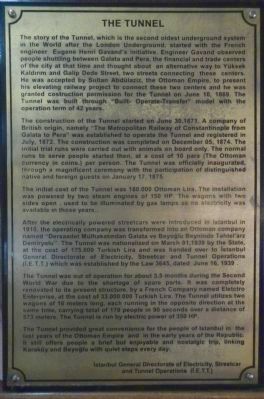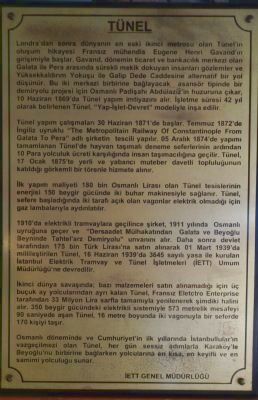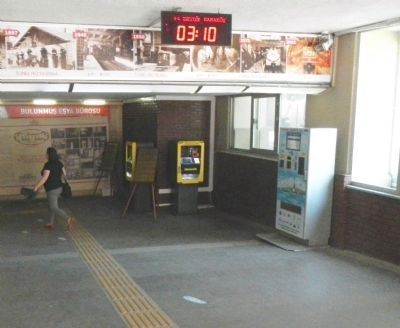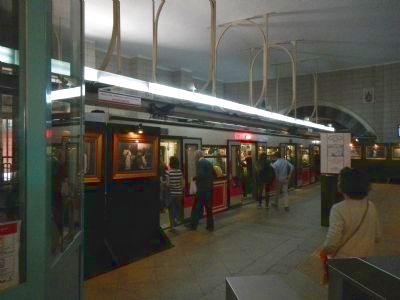Evliya Çelebi in İstanbul in Beyoğlu, Turkey — West Asia or Southeast Europe
The Tunnel
Tünel
The story of the Tunnel. which is the second oldest underground system in the World after the London Underground, started with the French engineer Eugene Henri Gavands initiative. Engineer Gavand observed people shuttling between Galata and Pera. the financial and trade centers of the city at that time and thought about an alternative way to Yüksek Kaldırım and Gaiip Dede Street, two streets connecting these centers. He was accepted by Sultan Abdülaziz, the Ottoman Empire, to present his elevating railway project to connect these two centers and he was granted construction permission for the Tunnel on June 10, 1869. The Tunnel was built through “Built - Operate -Transfer” model with the operation term of 42 years.
The construction of the Tunnel started on June 30,1871. A company of British origin, namely "The Metropolitan Railway of Constantinople from Galata to Pera" was established to operate the Tunnel and registered in July, 1872. The construction was completed on December 05, 1874. The initial trial runs were carried out with animals on board only. The normal runs to serve people started then, at a cost of 10 para (The Ottoman currency in coins.) per person. The Tunnel was officially inaugurated, through a magnificent ceremony with the participation of distinguished native and foreign guests on January 17, 1875.
The initial cost of the Tunnel was 180.000 Ottoman Lira. The installation was powered by two steam engines of 150 HP. The wagons, with two sides open, used to be illuminated by gas lamps as no electricity was available in those years.
After the electrically powered streetcars were introduced in Istanbul in 1910, the operating company was transformed into an Ottoman company named “Dersaadet Mülhakatınkan Galata ve Beyoǧlu Beyninde Tahtel'arz Demiryolu”. The Tunnel was nationalized on March 01,1939 by the state. at the cost of 175.000 Turkish Lira and was handed over to İstanbul General Directorate of Electricity, Streetcar and Tunnel Operations (İ.E.T.T.) which by the Law 3045, dated June 16, 1939.
The Tunnel was out of operation for about 3.5 months during the Second World War due to the shortage of spare parts. It was completely renovated to its present structure by a French Company name Electro Enterprise, at a cost of 33.000.000 Turkish Lira. The Tunnel utilizes town wagons of 16 meters long, each running in the opposite direction at the same time, carrying total of 170 people in 90 seconds over a distance of 573 meters. The Tunnel is run by electric power of 350 HP.
The Tunnel provided great convenience for the people of İstanbul in the last years of the Ottoman Empire and in the early years of the Republic. It still offers people a brief but enjoyable and nostalgic trip, linking Karaköy and Beyoǧlu with quiet steps every day.
Turkish:
Londra'dan sonra dünyanının en eski ikinci metrosu olan Tünel'in oluşun hikayesi Fransız mühendis Eugene Henri Gavand'ın girişimiyle başlar. Gavend, dönemin ticaret ve bankacılık merkezi olan Galata ile Pera arasında sürekli mekik dokuyan insanlar gözlemler ve Yüksekkaldırım Yokuşu ile Galip Dede Caddesine alternatif bir yol düşünür. Bu iki merkezi birbirine baǧlayacak asansör tipinde bir demiryolu projesi için Osmanlı Padişahı Abdülaziz'in huzuruna çıkar, 10 Haziran 1869'da Tünel yapım imtiyazını alır, işletme süresi 42 yıl olarak belirlenen Tünel, "Yap-İşlet-Devret" modeliye inşa edilir.
Tünel yapım çalışmaları 30 Haziran 1871'de başlar. Temmuz 1872'de İngiliz uyruklu "The Metropolitain Railway Of Constantinople From Galata To Pera" a tamamlanan Tünel'de hayvan taşımalı deneme seferlerinin ardından 10 Para yolculuk ücreti karşılığında insan taşımacılığına geçilir. Tünel, 17 Ocak 1875'te yerli ve yabancı
muteber davetli topluluǧunun katıldığı görkemli bir törenle hizmete alınır.
İlk yapım maliyeti 180 bin Osmanlı Lirası olan Tünel tesislerinin enerjisi 150 beygir gücünde iki buhar makinesiyle saǧlanır. Tünel sefere başladığında iki tarafı açık olan vagonlar elektrik olmadıǧı için gaz lambalarıyla aydınlatılır.
1910'da elektrikli tramvaylara geçilince şirket, 1911 yılında Osmanlı uyruğuna geçer ve "Dersaadet Mülhakatından Galata ve Beyoǧlu Beyninde Tahtel'arz Demiryolu" unvanını alır. Daha sonra devlet tarafından 175 bin Türk Lirası'na satın alınarak 01 Mart l939`da millileştirilen Tünel, 16 Haziran 1939'da 3645 sayılı yasa ile kurulan İstanbul Elektrik Tramvay ve Tünel İşletmeleri (İETT) Umum Müdürlüğü'ne devredilir.
İkinci dünya savaşında; bazı malzemeleri satın alınamadıǧı içın üç buçuk ay yolcularından ayrı kalan Tünel, Fransız Eletctro Enterprise tarafından 33 Milyon Lira sarfla tamamıyla yenilenerek şimdiki halini alır. 350 beygir gücündeki elektrikli sistemiyle 573 metrelik mesafeyi 90 saniyede aşan Tünel, 16 metre boyunda iki vagonuyla bir seferde 170 kişiyi taşır.
Osmanlı döneminde ve Cumhuriyet'in ilk yıllarında İstanbullular'ın vazgeçilmezi olan Tünel, her gün sessiz adımlarla Karaköy'le Beyoğlu'nu birbirine bağlarken yolcularına en kısa. en keyifli ve en samimi yolculuğu sunar.
Erected by İstanbul General Directorate of Electricity, Streetcar and Tunnel Operations (İ.E.T.T.).
Topics. This historical marker is listed in this topic list: Railroads & Streetcars. A significant historical month for this entry is January 1878.
Location. 41° 1.669′ N, 28° 58.315′ E. Marker is in İstanbul, in Beyoğlu. It is in Evliya Çelebi. Marker is on Meşrutiyet Caddesi close to SadiKonuralp Caddesi, on the left when traveling east. Touch for map. Marker is at or near this postal address: Meşrutiyet Cd 108, İstanbul 34430, Turkey. Touch for directions.
Other nearby markers. At least 8 other markers are within walking distance of this marker. Galata Tower (approx. 0.3 kilometers away); Galatasarayı Hamami (approx. 0.9 kilometers away); Rustem Pasha Mosque (approx. 1.2 kilometers away); The History of the Egyptian Bazaar (approx. 1.2 kilometers away); Mimar Sinan (approx. 1.4 kilometers away); Maksem Taksim (approx. 1.4 kilometers away); Sirkeci Terminal (approx. 1.5 kilometers away); The Building of Ministry of Post and Telegraph (Grand Post Office) (approx. 1.5 kilometers away). Touch for a list and map of all markers in İstanbul.
Credits. This page was last revised on February 13, 2023. It was originally submitted on June 30, 2015, by Barry Swackhamer of Brentwood, California. This page has been viewed 953 times since then and 52 times this year. Photos: 1, 2, 3, 4. submitted on June 30, 2015, by Barry Swackhamer of Brentwood, California. • Andrew Ruppenstein was the editor who published this page.



